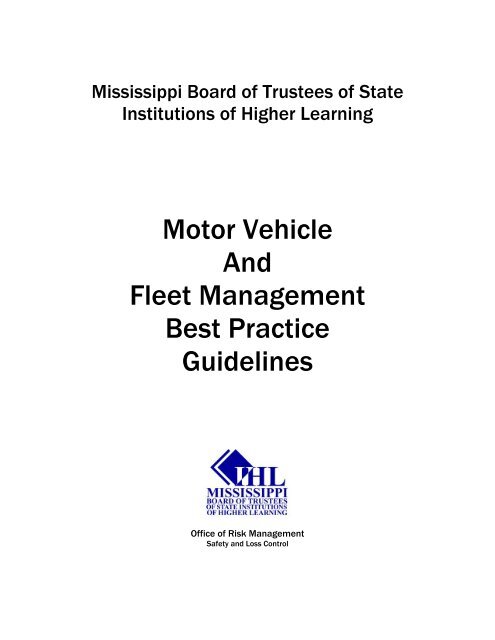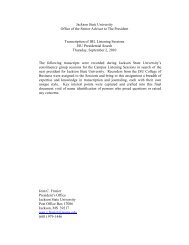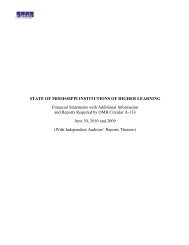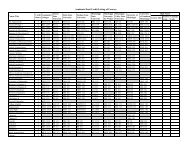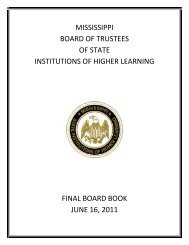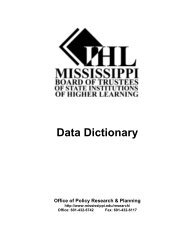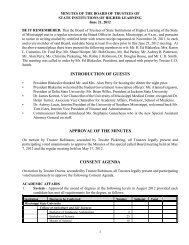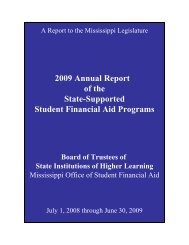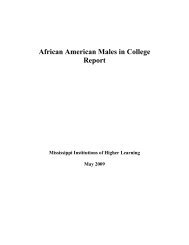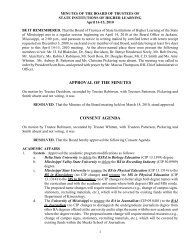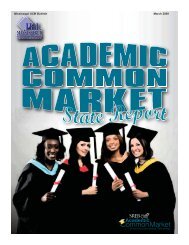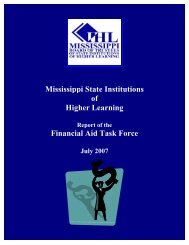Motor Vehicle And Fleet Management Best Practice Guidelines
Motor Vehicle And Fleet Management Best Practice Guidelines
Motor Vehicle And Fleet Management Best Practice Guidelines
Create successful ePaper yourself
Turn your PDF publications into a flip-book with our unique Google optimized e-Paper software.
Mississippi Board of Trustees of StateInstitutions of Higher Learning<strong>Motor</strong> <strong>Vehicle</strong><strong>And</strong><strong>Fleet</strong> <strong>Management</strong><strong>Best</strong> <strong>Practice</strong><strong>Guidelines</strong>Office of Risk <strong>Management</strong>Safety and Loss Control
ContentsGeneral………………………….……………………………………. 4Statement of PurposeApplicationEnforcement/Consequences<strong>Management</strong>.………………………………….………………………4General<strong>Motor</strong> PoolDepartmentalIndividually AssignedCombinationRisk <strong>Management</strong>………………………..…………………………..4Liability CoverageInjured EmployeeUniversity <strong>Vehicle</strong>Accident Reports<strong>Vehicle</strong>s………………………………………………………………..5UseUsage and Cost RecordkeepingFuelAppearanceMarkingTitle/License PlateMaintenanceInspectionState InspectionEmergency Equipment<strong>Vehicle</strong> ModificationsDrivers…………………………………………………………………6Authorized DriversDriver QualificationsDriver RecordsDriver Training<strong>Motor</strong> <strong>Vehicle</strong> and <strong>Fleet</strong> <strong>Management</strong> <strong>Best</strong> <strong>Practice</strong> <strong>Guidelines</strong> 2
ContentsOperation……………………………………….……………………. 7State and Federal LawOccupant SafetyDistractionsImpaired DrivingSafe and Courteous OperationParking/BackingDamaged/Malfunctioning <strong>Vehicle</strong>Specialty <strong>Vehicle</strong>s and Licensure………..…..……...………..… 8Emergency <strong>Vehicle</strong>sSpecial Apparatus/<strong>Vehicle</strong>VansMass Transit <strong>Vehicle</strong>sCommercial <strong>Vehicle</strong>Class of License and EndorsementsChartered Busses......................................................................10Rental <strong>Vehicle</strong>s……………………………………..………………10In StateOut of StatePrivately Owned <strong>Vehicle</strong>s…………………………………………11AuthorizationInsuranceExpenseSafetyAppendices…………………….……………………….……… 12-27A. Sample Business Use AgreementB. Sample Privately Owned <strong>Vehicle</strong>s Used for Business Purposes AgreementC. Sample Rental <strong>Vehicle</strong> Policy AcknowledgementD. <strong>Motor</strong> <strong>Vehicle</strong> Incident Reporting Instructions for DriversE. Factors to be Considered During an Incident ReviewF. Sample Driver’s Pre-Trip Inspection ChecklistG. Mississippi Department of Public Safety Driver Records RequestH. Van Safety RecommendationsI. Guide to Hiring Bus Companies<strong>Motor</strong> <strong>Vehicle</strong> and <strong>Fleet</strong> <strong>Management</strong> <strong>Best</strong> <strong>Practice</strong> <strong>Guidelines</strong> 3
This guide contains the basic elements that should be addressed by each universityconcerning the safe and legal use of vehicles operated by the university, whether theyare university owned, rented, or privately owned. The use of this guide will facilitatecontinuity across the IHL System with regard to elements addressed while allowingflexibility among member institutions as to how each element is addressed. Thefollowing elements are reflective of various state and federal laws and regulations,insurance industry standards, and safety standards. The following practices aredesigned to apply to motor vehicles that are licensed to operate on public roadways andthe drivers of such vehicles, in compliance with IHL Board Policy 711.06.GeneralStatement of Purpose: Explain that policies and/or procedures exist to promotethe safe, legal, and responsible use of vehicles owned or operated for the benefit ofthe university. The protection of life, property, and the good stewardship of publicresources is at stake.Application: These practices apply to any and all vehicles used for the benefit ofthe university that are licensed for travel on public roads.Enforcement/Consequences: Describe who will be responsible for enforcingpractices and who has the authority to apply consequences for non-compliance,and outline examples of possible consequences. Consider specifically violations ofrules that result in a threat to life, violations of law, and violations resulting incollision or injury.<strong>Management</strong>General: Senior leadership should endorse the overall vehicle operations and fleetmanagement program. Focus should be given to the safety of employees,students, and the public. Benefits of a comprehensive program include wisestewardship of public resources, a good public image, conservation of budget, andresponsibility to citizens. With consideration given to how vehicles are allotted,assigned, or managed, all levels of management should be involved in and heldaccountable for the program’s development, management, and implementation.If <strong>Motor</strong> Pool: Define guidelines for acquiring and returning vehicles. Also includeresponsibilities of motor pool with regard to appearance, maintenance, repair,recordkeeping, and inspections.If Departmental: Appoint a departmental coordinator or liaison responsible forappearance, assignment, maintenance, repair, recordkeeping, and inspections.If Individually Assigned: Define responsibilities regarding appearance,maintenance, repair, recordkeeping, and inspections.If Combination of Above: Provide information on each form of management asrelated to accountability.Risk <strong>Management</strong>Liability Coverage: Explain auto liability coverage. Ensure accurate and currentproof of coverage cards are kept in every vehicle. The MS Tort Claims Actprovides protection and is exclusive remedy only while the automobile is usedwithin the scope and course of one’s duties for the university. Within Mississippi,the limit is $500,000.00 per occurrence. Out of state, other state laws apply.<strong>Motor</strong> <strong>Vehicle</strong> and <strong>Fleet</strong> <strong>Management</strong> <strong>Best</strong> <strong>Practice</strong> <strong>Guidelines</strong> 4
Injured Employee: Explain Workers’ Compensation coverage. Workers’Compensation will apply as exclusive remedy to employees injured in a vehiclecollision while engaged in the course and scope of one’s duties for the university.University <strong>Vehicle</strong>: Explain the university policy regarding repair or replacement ofdamaged vehicles. Property and budget issues should be disclosed. If the otherparty was at fault, a claim against their insurance should be pursued.Accident Reports: Complete and accurate information must be reported to theappropriate insurance agent immediately. Provide a sample of the form to be usedand detail who should initiate the report and how the report should be distributed.Explain the consequences of failing to report accidents on a timely basis.<strong>Vehicle</strong>sUse: Explain authorized use and misuse. Limit operation of each vehicle to theintended use within the capacities as described by the manufacturer. Provide anavenue to match the vehicle to the job that needs to be performed. MS Code § 25-1-79 states that it is unlawful to use a university-owned vehicle for anything otherthan official business of the university.Usage and Cost Recordkeeping: Explain mileage, destination, and driverrecordkeeping requirements. Also explain maintenance, repair, operation cost, andother recordkeeping requirements.Fuel: Describe the procedure for acquiring fuel on and off campus. Explain rulesregarding usage, recordkeeping, and purchasing. Explain the federal excise taxexemption and budgetary implications.Appearance: Explain the university’s policy regarding its public image. Addressissues such as cleanliness, repairs, and conditions which are unacceptable foroperation.Marking: Provide information regarding requirements for the marking of universityownedvehicles in compliance with MS Code § 25-1-87. Identify who is responsiblefor ensuring that vehicles are properly marked and explain how to have vehiclesmarked properly.Title/License Plate: Explain how titles/license plates are acquired, who acquiresthem, and where they are kept for future reference. Include procedures for thetransfer of titles during disposal of vehicles.Maintenance: Identify maintenance schedules for various types of vehicles that arewithin the manufactures’ recommendations. Define who is responsible for adheringto the schedule and identify what records should be kept. Identify the qualificationsneeded by personnel authorized to perform maintenance. Provide procedures forresponding to recall notices. Explain purchasing authority and limitations or otherrelated financial details.Inspection: Describe university protocol regarding periodic safety inspections onvarious types of vehicles. Include pre-trip (driver), weekly, monthly, quarterly, andannual inspections as necessary. Provide forms to ensure adequate and consistentinspections. Identify who will perform which inspections. Explain what to do in thecase of exception items. Explain what documentation is required. Require annualstate inspections, and provide procedures for renewing each vehicle’s windshieldsticker.State Inspection – Identify the procedure for renewing each vehicle’s state<strong>Motor</strong> <strong>Vehicle</strong> and <strong>Fleet</strong> <strong>Management</strong> <strong>Best</strong> <strong>Practice</strong> <strong>Guidelines</strong> 5
inspection sticker. Encourage drivers to notify the proper person if they notice anout-of-date sticker.Emergency Equipment: <strong>Vehicle</strong>s should be equipped with appropriate emergencyequipment for use in the event of mechanical failure, crash, or other circumstancethat results in a disabled vehicle near the roadway. List items to be included, suchas warning triangles, first aid kit, fire extinguisher, and other equipment dependingon vehicle type and use.<strong>Vehicle</strong> Modifications: Describe university policy regarding modifications made touniversity-owned vehicles. Ensure that no modifications create an unsafe conditionor disable/circumvent any safety device. Designate personnel authorized toperform modifications. Consider such things as: radio equipment, towingequipment, security devices, material handling needs, and navigational devices.DriversAuthorized Drivers: Explain the university process to become an authorizeddriver. Identify personnel with the authority to authorize drivers. Provide a methodto document the authorization of each driver. Consider employee job descriptionsthat include driving as a job task. MS Code § 25-1-79 states that it is unlawful topermit or authorize the use of any university-owned vehicle for anything other thanofficial university business. It is recommended that the university not authorize nonemployeesas drivers of university-owned vehicles.Driver Qualifications: University policies and procedures should address thefollowing:1. Employees must have a valid Mississippi driver’s license, or a validdriver’s license from a contiguous state (MS Code § 25-9-153).2. Other authorized drivers must have a valid driver’s license issued in thestate or country of residency. An International Driver’s Permit from thecountry of residence must also be required of drivers possessing a validlicense from another country. Likewise, university personnel travelingabroad should obtain an International Driver’s Permit prior to travel.3. All drivers’ licenses must be of the appropriate classification and haveany required endorsements needed for operating the vehicle(s)assigned.4. Driver selection must include assessment to ensure drivers are mentallyand physically capable of the safe operation of the vehicle(s) assigned.5. Required experience should be established. One example is to requiredrivers to have held a driver’s license for at least 3 years. Increaserequired experience as the complexity of the vehicle(s) or the value ofthe vehicle(s) at risk increases.6. All qualifications should be reevaluated periodically. Define the partiesresponsible for reevaluations, and determine a schedule forreevaluations. Driving privilege should be removed if and when a driverbecomes unqualified.Driver Records: Documentation of driver qualifications and driving records shouldbe maintained by the authorizing entity. Drivers must therefore agree to abide bythe university’s policies and procedures and to provide the necessary informationor consent to allow the gathering of necessary information. Authorized driver files<strong>Motor</strong> <strong>Vehicle</strong> and <strong>Fleet</strong> <strong>Management</strong> <strong>Best</strong> <strong>Practice</strong> <strong>Guidelines</strong> 6
should contain the following:1. Authorized vehicle use agreement, signed by driver and supervisor. Seesamples in appendices A and B2. Release of information form, signed by driver3. Copy of current driver’s license4. Copies of driver medical exam results as required (CDL)5. Copies of drug and alcohol test records as required (CDL)6. Documentation of motor vehicle record (MVR) checks7. Training/testing records8. Documentation of any other form of periodic driver performanceevaluation, public feedback, citations, or accident reports9. Any other information related to the driver’s ability or inability to operate amotor vehicle as related to employmentDriver Training: Establish driver training standards to address an array of needsdepending on the type and amount of experience of the driver, the type of vehicledriven, the type and amount of cargo, the number of passengers, the length of thetrip, the requirements needed to maintain a license, remedial training needs, orother factors as identified by the university. The following subject matter should beconsidered:1. University policies and procedures regarding safety, driving, vehicle use,post-accident procedures, etc.2. State and federal laws3. Defensive driving4. Driver inspection and follow-up5. Operation of specific vehicle6. Operation and location of emergency equipment7. Cargo specific training8. Foreign driving regulations (for those traveling abroad)9. Security of passengers and vehicleOperationState and Federal Law: Establish that all drivers are responsible for operating thevehicle within the bounds of the state and federal laws that apply. Establishconsequences for violations of law while operating university vehicles. Considerparking violations, moving violations, violations resulting in a threat to life, violationsresulting in a collision, etc.Occupant Safety: Establish that the driver is responsible for ensuring that alloccupants have fastened their seatbelts (where supplied) prior to the operation ofany vehicle. Lap belts and shoulder harnesses should be included. Whereprovided, the number of seatbelts in a vehicle establishes the maximum number ofpassengers a vehicle can hold. Supplemental restraint systems (airbags) shouldnot be disabled. Loose material inside passenger compartments should be kept toa minimum. Smoking inside vehicles should be prohibited due to the concern forhealth, potential damage to the vehicle, and the distraction caused to the driver.Approved motorcycle helmets must be worn by all motorcycle riders (MS Code §63-7-64). Establish other requirements for protective clothing and determine themaximum number of personnel allowed on motorcycles.<strong>Motor</strong> <strong>Vehicle</strong> and <strong>Fleet</strong> <strong>Management</strong> <strong>Best</strong> <strong>Practice</strong> <strong>Guidelines</strong> 7
Distractions: Establish policies to minimize distractions that can interfere with thedriver’s ability or focus. Consider such issues as:1. Cell phone use2. PDA/laptop computer use3. MP3 use4. Portable two-way radio use5. Global positioning systems6. Eating/drinking7. Reading/writing8. Tobacco use9. Operation of other equipment such as lights, siren, camera, etc.Impaired Driving: Establish policies prohibiting the operation of a motor vehiclewhile mentally or physically impaired. Define violations and subsequentconsequences for each. Consider such issues as:1. The use of alcohol2. The use of illegal drugs3. The use of prescription medicine4. The use of non-prescription medicine5. Fatigue6. Medical condition or illness7. Emotional stateSafe and Courteous Operation: Explain that university-owned vehicles affect theuniversity’s image and so does the operation of those vehicles. The public expectssafe and courteous drivers in the vehicles provided. Unsafe or aggressive drivingcan create negative public impressions and result in bodily injury, death, orproperty damage. Identify consequences related to the following reportedbehaviors:1. Speeding2. Improper passing3. Failure to yield right-of-way4. Tailgating5. Failure to adjust to road or weather conditions6. Failure to use vehicle’s safety devices such as lights, wipers, turnsignals, etc.7. Improper gesturing, language, or use of horn or lights8. Other violations of law or improper conductParking/Backing: Include safety rules designed to prevent collisions from parkingand backing operations. Consider the use of observers to guide the driver, parkingso as to avoid the need to back into traffic, walking around vehicle prior to backing,observing other drivers in crowded parking lots. Include university policy regardingwhen to lock vehicles and where keys may be secured.Damaged/Malfunctioning <strong>Vehicle</strong>: Describe the driver’s duty to report damage toa vehicle as soon as possible, and explain the procedure for doing so. Explain theprocedures to be followed if a vehicle malfunctions, and define unsafe conditions inwhich a vehicle must be parked until the situation can be remedied.<strong>Motor</strong> <strong>Vehicle</strong> and <strong>Fleet</strong> <strong>Management</strong> <strong>Best</strong> <strong>Practice</strong> <strong>Guidelines</strong> 8
Specialty <strong>Vehicle</strong>s & LicensureEmergency <strong>Vehicle</strong>s: Describe training and equipment requirements for theoperation of emergency vehicles such as patrol cars, ambulances, and fire trucks,as applicable. Provide information regarding regulating authorities or others withauthority to enforce established standards. Describe any additional operator’slicense or permit requirements as well as specific inspection criterion, certificationor documentation procedures related to emergency vehicles.Special Apparatus/<strong>Vehicle</strong>: Describe training and equipment requirements for theoperation of specialty vehicles such as motorcycles, boom trucks, dump trucks, towtrucks, etc., as applicable. Provide information regarding regulating authorities orothers with authority to enforce established standards. Describe any additionaloperator’s license or permit requirements as well as specific inspection criterion,certification or documentation procedures related to specialty vehicles.Vans: Create a special section as necessary regarding various sizes of vans,especially 15-passenger vans. Note the hazards, safety precautions, driverqualifications and other university policies that may apply. See Appendix H.Mass Transit <strong>Vehicle</strong>s: Create a special section as necessary to addressrequirements of mass transit systems as prescribed by the Federal TransitAdministration, cooperating partners, and grant-related agreements.Commercial <strong>Vehicle</strong>: Describe training, recordkeeping, and equipmentrequirements for the operation of commercial motor vehicles as identified by theFederal <strong>Motor</strong> Carrier Safety Administration and the Federal Department ofTransportation. Provide information regarding regulating authorities or others withauthority to enforce established standards. Describe any additional operator’slicense requirements or specific inspection criterion, certification, or documentationprocedures.Class of License and Endorsements: Address the required licensure for variousuniversity-owned vehicles. Provide method of compliance with MS Code Title 63Article 1 and Article 2. Explain requirements for:1. Class R – Regular License. No person shall drive or operate a motorvehicle other than a motorcycle upon the highways of the State ofMississippi without first securing an operator's license to drive on thehighways of the state.A motorcycle endorsement may be issued to any person who holds avalid Mississippi driver's license and meets the other requirements forsuch endorsement contained in this chapter.A restricted motorcycle operator's license may be issued to anyapplicant who fulfills all the requirements necessary to obtain aMississippi operator's license that may be applicable to the operationof a motorcycle. Such license shall entitle the holder thereof tooperate a motorcycle, and no other motor vehicle, upon the highwaysof this state.2. Class A. Any combination of vehicles with a gross vehicle weight ratingof twenty-six thousand one (26,001) pounds or more, provided the grossvehicle weight rating of the vehicle or vehicles being towed is in excessof ten thousand (10,000) pounds;<strong>Motor</strong> <strong>Vehicle</strong> and <strong>Fleet</strong> <strong>Management</strong> <strong>Best</strong> <strong>Practice</strong> <strong>Guidelines</strong> 9
3. Class B. Any single vehicle with a gross vehicle weight rating of twentysixthousand one (26,001) pounds or more, and any such vehicle towinga vehicle not in excess of ten thousand (10,000) pounds;4. Class C. Any single vehicle with a gross vehicle weight rating of lessthan twenty-six thousand one (26,001) pounds or any such vehicletowing a vehicle with a gross vehicle weight rating not in excess of tenthousand (10,000) pounds comprising:a. <strong>Vehicle</strong>s designed to transport sixteen (16) or more passengers,including the driver; andb. <strong>Vehicle</strong>s used in the transportation of hazardous materials whichare required to be placarded under the Hazardous MaterialsTransportation Act, 49 USCS Appx., Section 1801 et seq.; and5. Class D. All other vehicles or combination of vehicles which are notincluded in Class A, Class B, or Class C and for which a commerciallicense is required to be issued as provided by Section 63-1-43,Mississippi Code of 1972.6. Commercial driver's licenses may be issued with the followingendorsements and restrictions:a. "H" authorizes the driver to drive a vehicle transporting hazardousmaterials;b. "K" restricts the driver to vehicles not equipped with air brakes;c. "T" authorizes driving double and triple trailers;d. "P" authorizes driving vehicles carrying passengers;e. "N" authorizes driving tank vehicles;f. "X" represents a combination of hazardous materials and tankvehicle endorsements;g. "S" restricts the driver to school buses being operated for thepurpose of transporting pupils to and from school or to schoolrelatedfunctions and/or to all other vehicles not requiring acommercial driver's license; andh. "I" restricts driving which requires a commercial license tointrastate driving onlyChartered BussesContracting for vehicles and drivers: Describe the procedure for contracting forvehicles and drivers; and identify the approval process and who has authority toenter into outside contracts. Describe the minimum elements required in contracts.See Appendix I for a guide to hiring bus companies.Rental <strong>Vehicle</strong>sIn State: Explain the state contract administered by the Mississippi Department ofFinance and Administration for <strong>Vehicle</strong> Rental Services, In State. Describe detailssuch as allowable use, authority, application, restrictions, requirements, allowableexpenses, and procedures. Explain free Collision Damage Waiver (CDW)/LossDamage Waiver (LDW) insurance and include procedures for reporting damage orcollision while operating a rental vehicle. Explain that additional insurance shouldnot be purchased if CDW/LDW is part of the state contract. CDW/LDW covers<strong>Motor</strong> <strong>Vehicle</strong> and <strong>Fleet</strong> <strong>Management</strong> <strong>Best</strong> <strong>Practice</strong> <strong>Guidelines</strong> 10
damage to the rental car and IHL’s existing auto insurance covers third partydamage/injuries at the fault of the university authorized driver. Additional liabilityinsurance should not be purchased/reimbursed.Out of State: Explain the state contract administered by the MississippiDepartment of Finance and Administration for <strong>Vehicle</strong> Rental Services, Out ofState. Describe details such as allowable use, authority, application, restrictions,requirements, allowable expenses, and procedures. Explain Collision DamageWaiver (CDW)/Loss Damage Waiver (LDW) insurance and include procedures forreporting damage or collision while operating a rental vehicle. Explain thatadditional insurance should not be purchased if CDW/LDW is part of the statecontract. CDW/LDW covers damage to the rental car and IHL’s existing autoinsurance covers third party damage/injuries at the fault of the university authorizeddriver. Additional liability insurance should not be purchased/reimbursed.Privately Owned <strong>Vehicle</strong>sAuthorization: University officers and employees may be authorized to travel onuniversity business using their private automobile. This section should outline theprocedure for obtaining authorization according to state law and university policy.Insurance: Owners should have current proof of insurance in accordance withstate law. Losses occurring to a third party while conducting official business withprior approval are subject to protections provided by the Mississippi Tort Claims Act§ 46-11-1 et. al.Expense: University employees that are authorized to travel on official statebusiness in their private automobile will be reimbursed at the same rate, based onmileage, as federal employees as determined by the Mississippi Department ofFinance and Administration. All other operational and maintenance expenses arethe responsibility of the owner.Safety: If authorized for official use, privately owned vehicles will be operated andmaintained in accordance with the policies and procedures established foruniversity-owned vehicles.<strong>Motor</strong> <strong>Vehicle</strong> and <strong>Fleet</strong> <strong>Management</strong> <strong>Best</strong> <strong>Practice</strong> <strong>Guidelines</strong> 11
Appendix ASample Business Use AgreementOperating a university vehicle is a privilege. All drivers will be responsible and accountable to:• Possess a valid motor vehicle driver’s license issued in Mississippi or a state contiguous toMississippi. This license must have the appropriate classification and any requiredendorsements needed for operating the vehicle(s) assigned to the operator.• Be subject to a driver’s motor vehicle record check, and if such records show a suspensionor revocation of driving privileges, the driver will not be authorized to operate a motor vehiclefor the university.• Operate university vehicles for official university business only.• Operate motor vehicles in a safe manner at all times.• Comply with all applicable state laws and regulations.• Maintain vehicle in a safe operating condition.• Maintain vehicle in accordance with the maintenance schedule.• Report moving violations to their Supervisor.• Report changes in their driver’s licensing to the university’s personnel or insurance/riskmanagement department.• Accurately complete a condition survey when turning in a university vehicle.• Accurately record and report vehicle mileage in accordance with university procedures.• Participate in required driver safety education and training programs.• Require all occupants to use seat belts, child safety seats, booster seats, or other restraintdevices at all times.• Pay all moving/parking violation fines and fees.• Keep automobile ID cards in the vehicle glove box at all times, including proof of liabilitycoverage.• Refrain from towing any personal equipment (boats, campers, etc.) with university vehicle.• Not alter vehicles leased, owned, or rented by the university in any way.• Never deactivate air bags on any leased/owned university vehicles, rented, or personalvehicles used for university business.<strong>Motor</strong> <strong>Vehicle</strong> and <strong>Fleet</strong> <strong>Management</strong> <strong>Best</strong> <strong>Practice</strong> <strong>Guidelines</strong> 12
• Never operate a computer while the vehicle is moving.• Pull off the road to a safe location prior to making or receiving phone calls.• Comply with university policy on transport of passengers.Operating privileges shall be revoked if:• Driver does not adhere to responsibilities listed above.• The driver’s license is revoked, suspended, withdrawn, or denied.• Driver refuses to undergo drug or alcohol testing in accordance with university policies or asrequired by applicable state or jurisdiction laws.• Operating outside the limitations of a restricted license.In case of vehicle damage:• Report any vehicle damage to the university by the end of the day in which the incidentoccurred.• Police reports, witness statements or other pertinent documents should be obtained andforwarded to the university.• The driver shall cooperate with representatives of the university, including insurancecompany personnel, and obtain written repair estimates from reputable shops or authorizeddealerships as instructed. If it becomes necessary to rent another vehicle during repairs, thedriver will be instructed as to provisions for a rental vehicle.• Drivers should not make verbal or written statements concerning an incident during itsimmediate aftermath except to law enforcement officials or representatives of the universityor its agents.I, _______________________, have read and understand the Business Use Policy establishedby ______________________. I agree to abide by the provisions of this policy. I understandthat violation of this policy will result in disciplinary action, up to and including termination ofemployment.__________________________Driver Signature_____________Date__________________________Supervisor Signature_______________Date<strong>Motor</strong> <strong>Vehicle</strong> and <strong>Fleet</strong> <strong>Management</strong> <strong>Best</strong> <strong>Practice</strong> <strong>Guidelines</strong> 13
Appendix BSample Privately Owned <strong>Vehicle</strong>s Used for Business Purposes AgreementThere are situations where drivers use their personal vehicles for university business. In thesecases, drivers are typically reimbursed on a per-mile basis. For those drivers utilizing theirpersonal vehicles on university business, the following requirements apply:• Must have a valid driver license issued in Mississippi or a state contiguous to Mississippiand meet the same motor vehicle record (MVR) and accident criteria as drivers of universityvehicles.• Automobile liability coverage must be maintained by the driver as prescribed by state law.The university shall be provided with evidence of this insurance coverage, which clearly listspolicy declarations and coverage limits.• In case of an accident and subsequent claim, third party losses are subject to theprotections provided by the Mississippi Tort Claims Act § 46-11-1 et. al. (subject to allrequirements and limitations) only if the loss occurred while conducting official universitybusiness.• The vehicle must be maintained at owner’s expense, in accordance with state law.• Drivers must comply with all applicable state laws and regulations.• <strong>Motor</strong> vehicle records will be checked initially, and periodically thereafter. The driver'sauthorization to operate their personal vehicle for university business may be revoked bymanagement if the motor vehicle record discloses the following:• The motor vehicle driver license is revoked, suspended, withdrawn, or denied• Operating outside the limitations of a restricted license• Driver refuses to undergo drug or alcohol testing in accordance with university policies oras required by applicable state or jurisdiction laws• A conviction for driving a motor vehicle while under the influence of alcohol or illegaldrugs• Regular occasional drivers (those being reimbursed more than six times per year forbusiness use) may be required to attend driver safety training and meetings.The university reserves the right to withdraw this privilege at any time.I, _______________________, have read and understand the Privately Owned <strong>Vehicle</strong>s Usedfor Business Purposes Agreement established by______________________. I agree to abideby the provisions of this policy. I understand that violation of this policy will result in disciplinaryaction, up to and including termination of employment.__________________________Driver Signature______________Date__________________________Supervisor Signature_______________Date<strong>Motor</strong> <strong>Vehicle</strong> and <strong>Fleet</strong> <strong>Management</strong> <strong>Best</strong> <strong>Practice</strong> <strong>Guidelines</strong> 14
Appendix CSample Rental <strong>Vehicle</strong> Policy Acknowledgement<strong>Vehicle</strong>s may be rented for university business in certain circumstances, such as:• Out of town travel• Replacement vehicle for one that is being repaired• Transportation of guests• Special events• Unexpected shortage of transportation resourcesWhile operating a rental vehicle on university business, all requirements of the vehicle safetyprogram apply. This includes the following:• Must have a valid driver’s license, and meet the same motor vehicle record (MVR) andaccident criteria as all other drivers of university vehicles.• Drivers must comply with all applicable laws and regulations.• Only authorized drivers may operate the vehicle.NOTE: Ask to verify that CDW/LDW insurance is included at no additional cost. It should beincluded with all contract rentals. Employees will not be reimbursed for insurance charges ifCDW/LDW is part of the contract. IHL’s existing auto insurance covers third partydamage/injuries at the fault of the university authorized driver. Additional liabilityinsurance should not be purchased/reimbursed.I, _______________________, have read and understand the Rental <strong>Vehicle</strong> Policy establishedby______________________. I agree to abide by the provisions of this policy. I understand thatviolation of this policy will result in disciplinary action, up to and including termination ofemployment.__________________________Driver Signature______________Date__________________________Supervisor Signature_______________Date<strong>Motor</strong> <strong>Vehicle</strong> and <strong>Fleet</strong> <strong>Management</strong> <strong>Best</strong> <strong>Practice</strong> <strong>Guidelines</strong> 15
Appendix D<strong>Motor</strong> <strong>Vehicle</strong> Incident Reporting Instructions for DriversOn-scene instructions to be placed in the vehicle should include gathering the followinginformation if able:• Phone number(s) to which incidents are to be reported.• Insurance carrier information that can be provided to other involved parties.• Instructions for notifying the university’s insurance carrier (if the university’s reportingprocedures designate this as a driver responsibility).• Instructions for contacting law enforcement and emergency personnel; and instructions forcontacting roadside assistance services, if available.• Instructions for leaving the incident scene intact, securing the scene against furthercollisions or injuries until emergency personnel arrive, and meeting regulatory requirements(if any) for blood alcohol testing.• A reminder to the driver that he or she should not admit fault for the incident.Materials to consider placing in vehicle may also include a disposable camera for documentingthe scene, a witness card for recording initial comments and contact data from potentialwitnesses, and a pen or pencil. Current Proof of Coverage from the liability insurance carriershould always be kept in vehicle.Incident Information: Recommended information to be collected in the event of a motor vehicleincident are as follows:• Name of other driver(s)• Address of other driver(s)• Phone number(s) of other driver(s)• Driver’s license number(s) of other driver(s)• License plate number(s)• <strong>Vehicle</strong> make and model• Name of insurance carrier• Insurance policy number• Name, address, and phone number(s) of all parties involved in the incident, includingpassengers in each vehicle<strong>Motor</strong> <strong>Vehicle</strong> and <strong>Fleet</strong> <strong>Management</strong> <strong>Best</strong> <strong>Practice</strong> <strong>Guidelines</strong> 16
• Name, address, and phone number(s) of all witnesses• Date and time of the incident• Location of the incident (intersection or milepost)• The party to whom the driver’s vehicle was registered (e.g., the university, the driver,another individual, or a rental agency)• Name and phone number(s) of the investigating law enforcement officer on the scene, if any• Any other entities responding at the scene (e.g., fire department, ambulance, hazardousmaterials unit)• Citations issued• A detailed narrative of the incident• Space to allow the driver to make a sketch or diagram of the incident scene<strong>Motor</strong> <strong>Vehicle</strong> and <strong>Fleet</strong> <strong>Management</strong> <strong>Best</strong> <strong>Practice</strong> <strong>Guidelines</strong> 17
Appendix EFactors to be Considered During an Incident ReviewDuring a review of a motor vehicle incident, possible contributing factors may be consideredusing the following framework:Driver:Driver’s work schedule for at least the week preceding the incidentLength of time on duty since the previous break prior to the incidentFatigueScheduling demands on driver<strong>Motor</strong> vehicle record historyPhysical condition of the driver at the time of the incidentPhysical limitations of the driver at the time of the incidentTraining historyDriver’s emotional state<strong>Vehicle</strong>:Maintenance and inspection records<strong>Vehicle</strong> conditionDamage to the vehicle from the incidentSuitability and safety of the vehicle for the work task<strong>Vehicle</strong> control layoutModifications to the vehicle that may have contributed to the incidentOperating Environment:WeatherRoad conditionsTraffic conditionsRoute planningDelivery or service schedulesReferencesThe following provides further information on factors that may be considered in determiningcausation:NHTSA. Large truck crash causation study in the United States. U.S. Department ofTransportation, National Highway Traffic Safety Administration:http://www-nrd.nhtsa.dot.gov/pdf/nrd-01/esv/esv18/cd/files/18ESV-000252.pdfA guide to determine motor vehicle accident preventability (revised edition). National SafetyCouncil [2004]. Publication No. 22972-0000. Itasca, IL: National Safety Council.U.S. Department of Transportation [1991]. Accident countermeasures manual:http://www.fmcsa.dot.gov/factsfigs/accidenthm/accidentman.htm<strong>Motor</strong> <strong>Vehicle</strong> and <strong>Fleet</strong> <strong>Management</strong> <strong>Best</strong> <strong>Practice</strong> <strong>Guidelines</strong> 18
Appendix FSample Driver’s Pre-Trip Inspection ChecklistThe following checklist is designed for drivers with little mechanical knowledge or background.Elements included enhance safety and prevent breakdown. This inspection should only take afew minutes for a typical automobile. Completion will increase the likelihood of a successful trip.Unsatisfactory elements should be corrected prior to operation of vehicle.<strong>Vehicle</strong> Make & Model ______________________Date ___________________ELEMENTSATISFACTORY()UNSATISFACTORY( OR COMMENT)1. Brakes – do service brakes and parking brakeoperate?2. Lights – check headlights, high beams, blinkers,tail lights, brake lights, back-up light, parking lightsand side markers. Are all working?3. Tires – check pressure against p.s.i. noted ontire. Check tread depth (at least 1/8 inch). Checkfor defects such as unusual wear pattern, bubblesor deformed sidewalls.4. Belts – are they quiet with engine running?5. Glass – no broken windows, no cracks thatinterfere with driver’s vision. Clean.6. Mirrors – are side and rearview mirrors intact?7. Windshield wipers – do they operate andremove washer fluid when tested?8. Windshield washer – is reservoir full, does itpump when operated?9. Engine oil – check dipstick. Any leaks?10. Coolant – is fluid to mark on reservoir?11. Transmission – check dipstick. Any problemsshifting?12. Steering – does steering react when steeringwheel is turned? Any noise?13. Occupant restraints – are all seatbelts andairbags present? Do seatbelts operate properly?14. State inspection sticker – is a currentinspection sticker in lower driver’s side corner ofwindshield?15. License Plate – is a license plate mounted andeasily seen?16. Emergency equipment – is there a jack, lugwrench, flashlight, etc.?17. Keys – do keys operate ignition and all locks?Are a spare set of keys available?Note: Consider a similar checklist for use when returning a vehicle after a trip to report needed repairs.<strong>Motor</strong> <strong>Vehicle</strong> and <strong>Fleet</strong> <strong>Management</strong> <strong>Best</strong> <strong>Practice</strong> <strong>Guidelines</strong> 19
Appendix GMISSISSIPPI DEPARTMENT OF PUBLIC SAFETY DRIVER RECORDS REQUESTDRIVER SERVICES POLICY: 6-9(A)DRIVER NAME: _______________________DL NO: _____________DOB: _______________I HEREBY REQUEST THE FOLLOWING RECORDS RELATING TO THE ABOVE-NAMEDPERSON:Record Requested:______ MVR Summary______ Other Record (must be specified)CHECK THE FOLLOWING APPLICABLE STATEMENT:___ I am the person named in the record sought.Type ID Shown ____________________ Authorized Agent___ I am requesting the information on behalf of the current owner (written authorization fromrecord owner required).___ The information is to be used by a legitimate business or its agents, employees, orcontractors for use in the normal course of business only:a. To verify the accuracy of personal information submitted by the individual to thebusiness or its agents, employees.b. If such information as submitted is not correct, or no longer correct, to obtain thecorrect information for the sole purpose of preventing fraud by pursuing legal remediesagainst, or recovering on a debt or security interest against the individual.___ The information is to be used in conjunction with a civil, criminal, administrative or arbitralproceeding in a federal, state or local court or agency or before any self-regulatory body,including service of process, investigation in anticipation of litigation and the execution orenforcement of a judgment or order, or pursuant to an order of any court.___ The information is to be used by an insurer or insurance support organization, or by a selfinsuredentity, or its agents, employees or contractors in connection with the claimsinvestigation activities, anti-fraud activities, rating or underwriting.___ I represent a license private investigative agency or licensed security service and theinformation will be utilized for one of the above listed permitted purposes.___ For use by an employer or its agency or insurer to obtain or verify information relating to aholder of a commercial driver’s license that is required under the Commercial <strong>Motor</strong><strong>Vehicle</strong> Safety Act of 1986 (49 U.S.C. App. 2710, et seq.).___ For use in connection with the operation of private toll transportation facilities.___ For use by a government agency, court or law enforcement agency in carrying out itsfunctions.___ For use in connection with matters of motor vehicle or driver safety and theft, motor vehicleomissions, recalls, performance monitoring and the like.___ For use in the normal course of business by a legitimate business to verify accuracy ofpersonal information submitted by the individual to the business and if the information isincorrect, to obtain the correct information, but only for fraud prevention or recoveringdebts from the individual.Continued on next page<strong>Motor</strong> <strong>Vehicle</strong> and <strong>Fleet</strong> <strong>Management</strong> <strong>Best</strong> <strong>Practice</strong> <strong>Guidelines</strong> 20
___ For use in connection with any civil, criminal or administrative proceeding in any federal,state or local court or agency for service of process or enforcement of judgments.___ For use in research activities so long as the personal information is not published,redisclosed or used to contact the individual.___ For use by an insurance company for claims investigation, rating or underwriting.___ For use in notifying owners of towed or impounded vehicles___ For use by any licensed private investigator for any purpose permitted under the DPPA.___ For use by an employer to obtain or verify information relating to the holder of a commercialdriver license.___ For use in connection with the operation of private toll transportation facilities.___ For any other use authorized by state law, if the use relates to motor vehicle operation orpublic safety.I understand the personal information furnished is confidential under Federal and State law andis being released to me only for the reason I have indicated above and that it is unlawful for meto furnish the information to an unauthorized person or entity.Printed Name of Individual: ________________________________Signature: ____________________________ Date: ___________RepresentingPrinted Name of Company: _________________________________Address: ___________________________________________________________________City: _________________ State: ____________ Zip:__________You may mail the form with an $11.00 money order per request to: Department of Public SafetyAttn: MVR1900 E. Woodrow WilsonDPPA-3 Jackson, MS 39216<strong>Motor</strong> <strong>Vehicle</strong> and <strong>Fleet</strong> <strong>Management</strong> <strong>Best</strong> <strong>Practice</strong> <strong>Guidelines</strong> 21
Appendix HMississippi Institutions of Higher LearningSafety and Loss ControlVan Safety RecommendationsThe question is often asked, “Why are we so concerned about 15-passenger vans?”Two reasons are paramount, among others: first is the documented fact that thesevehicles have demonstrated a propensity to be involved in roll-over crashes, with a 70%fatality rate. The second reason is the rather precious cargo (human lives) that istypically on board, and the amount of this cargo. When something goes wrong, it can gowrong in a big way.“Where do we get our information?”, is usually the second question. The standardbearer in this issue is the National Highway Traffic Safety Administration (NHTSA),which was created in Highway Safety Act of 1970. The NHTSA is responsible forreducing deaths, injuries, and economic losses due to traffic crashes. This isaccomplished through research into traffic conditions, driver behavior, and vehicledesign and then promoting ideas and strategies to improve overall safety on Americanroads.A 2004 NHTSA study (and 49-page report) explored the relationship between vehicleoccupancy and several other variables in the NHTSA Fatality Analysis and ReportingSystem (FARS) database and a 15-passenger van's risk of rollover. The studyexamines statistics on fatal crashes involving 15-passenger vans from 1990 to 2002.The study also constructs a logistic regression model to model the effects of variousfactors, most importantly occupancy level, on the risk of rollover. The model isconstructed using data from 1994 to 2001 on police-reported motor vehicle crashes infive states that are part of NHTSA's State Data System (SDS).The data show that between 1990 and 2002, there were 1,576 15-passenger vansinvolved in fatal crashes that resulted in 1,111 fatalities to occupants of such vans. Ofthese, 657 vans were in fatal, single vehicle crashes, of which 349 rolled over. In 450 ofthese vans, there was at least one fatality, totaling up to 684 occupant fatalities insingle-vehicle crashes. The majority of fatally injured van occupants were not wearingseat belts. Only 14 percent of the fatally injured were restrained. Analysis of data fromNHTSA's SDS reveals that the rate of rollover observed for 15-passenger vans that areloaded above half their designed seating capacity is 2.2 times the rate observed forvans loaded to or below half their capacity. The odds of a rollover for a 15-passengervan at its designated seating capacity is more than five times the odds of a rolloverwhen the driver is the only occupant in the van.The agency also performed computer modeling to assess the handling of thesevehicles. The modeling predicted under-steer for 15-passenger vans when lightlyloaded, similar to minivan behavior. However, when heavily loaded, it predicted understeerat low lateral acceleration, but over-steer at higher lateral accelerations. Thistransition to over-steer may pose safety problems for drivers who are unfamiliar with thischaracteristic. Loading 15- passenger vans to gross vehicle weight (GVW) also movedcenter of gravity rearward, increasing vertical load on rear tires.<strong>Motor</strong> <strong>Vehicle</strong> and <strong>Fleet</strong> <strong>Management</strong> <strong>Best</strong> <strong>Practice</strong> <strong>Guidelines</strong> 22
What makes 15-passenger vans so dangerous? Begin answering this by recognizingthat these vans were originally designed to haul cargo - not people. Therefore, many ofthe safety features associated with typical passenger vehicles (like mini-vans, orbusses) was omitted. In fact, 15-passenger vans are more like trucks, while mini-vansare more like cars. They have truck chassis, truck suspensions, truck tires, and truckengines. Mini-vans are built on car chassis, with car suspensions and tires and engines.The 15-passenger vans are higher off the ground, longer, taller, heavier, have lessvisibility, and are more powerful than typical passenger vehicles. Add the weight of 15people and some gear and you’ve got quite a truck-driving job ahead of you. Whoever isdriving needs to be skilled, trained, and experienced.Why can’t we load them to maximum capacity? The center of gravity of an empty van isalready higher than most passenger vehicles. The risk of having a roll-over crash isabout the same as for a pick-up truck, while the van is empty. As you add passengers,you add weight above the axles. If you pack the rear of the van first, you add weightbehind the rear axle, shifting the center of gravity not only upward, but to the rear. Thisresults in less ground pressure at the front, where you count on the front tires to steerwith. The NHTSA report cited earlier stated that by the time you have ten people onboard, you’ve tripled the risk of rollover that you had with only a driver on board. Fill allfifteen seats and the risk is now five times greater. Add in the difficulty in steeringbecause your front wheels are barely touching the ground (and may even be coming offthe ground if driving over bumps), and the risk is unacceptable.Why all the focus on tires? Tire failure has been cited in many of the fatal crashesassociated with these vans. With a vehicle weighing over 9,000 pounds, tires need to beabove average. Manufacturers specify that light-truck (LT) tires are to be used for thesevehicles rather than passenger (P) tires. The LT tires have many different qualities butthe ability to take the weight and turn corners with it are two important ones. KenTestorff, in a report he wrote for the U.S. Navy states that “a random check ofgovernment-owned and leased 15-passenger vans in mid-2001 revealed some hadimproper replacement tires installed. When tires don’t meet the manufacturer’sminimum standards for size, pressure, and load, you’re asking for problems. Heatrapidly builds up in such cases, creating the potential for tire failure, which can cause adriver to lose control and wreck.”Tire pressure, even with the proper tires, must be checked with a gauge and adjusted tothe tire and vehicle specifications. If you have the correct tires, this should be the samefor both. Begin by checking the federal certification sticker usually found on the driver’sdoor pillar. This lists the vehicle’s gross weight load limits (per axle), required tire typeand size, and cold inflation pressure for front and rear tires. Compare this to the tiresthat are actually on the van. If sub-standard tires are present, they should be replacedprior to further use. Note that the pressures usually differ from front to rear. The front isusually about 50 p.s.i. while the rear is usually about 80 p.s.i. Only a good tire pressuregauge will tell you if you need more air.Why are 15-passenger van wrecks so often fatal? Eighty (80) percent of those who diedin 15-passenger van crashes were not wearing their seat-belts. Even people whonormally wear seat-belts don’t feel the need, or don’t remember, to wear them when<strong>Motor</strong> <strong>Vehicle</strong> and <strong>Fleet</strong> <strong>Management</strong> <strong>Best</strong> <strong>Practice</strong> <strong>Guidelines</strong> 23
they get inside a van. The driver is the one person who usually remembers to fasten hisor her seatbelt, and is the one person who can remind others to do so - or the vandoesn’t leave the parking lot!Lastly, what are your recommendations? The following were arrived at after studyingnumerous university, military, and other government agency procedures, NHTSAstatistics and reports, and advice from the National Safety Council’s Defensive DrivingCourse. They are written from the standpoint of preventing loss of life while still beingable to accomplish objectives. Input has come from several universities within the IHLsystem. Universities can create their own procedures based on theserecommendations. While stricter standards may be chosen, these recommendationsshould be considered minimum allowable considerations. Recommendations may bechanged or added in the future as additional information is obtained.Summary of RecommendationsIHL Safety and Loss Control1. Drivers should be experienced.How this is measured can vary:a. Having held a driver’s license for at least five yearsb. Being of a certain age (25 is common) assuming they have beendriving since the earliest allowable age (15 in MS)c. Having driven a truck or other large vehicle could be part ofexperience (10 years driving a motorcycle may not help much whendriving a 9,000 + lb. van with 15 lives on board)2. Drivers should be skilled.Do they have a good driving record, and does it include vans or similarvehicles?3. Drivers should be trained.A driver training course should include a minimum of 4 hours in theclassroom and should require demonstrated successful performancebehind the wheel on a closed course. Content should include reference toactual university-owned vans, characteristics, manufacture’sspecifications, maintenance, accident statistics, risks, load placement,capacity, operation, defensive driving strategies, university policies,route/trip planning, emergency procedures, and other topics as identified.4. Driving time should be limited.Fatigue is a common factor in crash statistics. Universities should adopt apolicy to prevent driver fatigue while safely accomplishing the mission ofthe group traveling. Consider driving time as related to wakeful time withina 24 hour period. A standard work day being eight hours, this might be agood limit for the average driver. The Department of Transportation allowsmore hours behind the wheel for commercial truck drivers, but requires thenext eight hours to be “off duty”. Taking a ten-minute break every 100<strong>Motor</strong> <strong>Vehicle</strong> and <strong>Fleet</strong> <strong>Management</strong> <strong>Best</strong> <strong>Practice</strong> <strong>Guidelines</strong> 24
miles or two hours is also a recommendation of the National SafetyCouncil.5. Time of day should be limited.National Safety Council discourages driving between the hours of midnightand 6:00 a.m. due to the condition of other drivers and the likelihood offatigue and/or meeting other drivers who are intoxicated.6. Drivers should be held responsible for the safe and lawful operation of thevehicle they are driving.Auto insurance and the MS Tort Claims Act will apply to liabilities whileoperating in the course and scope of one’s duties. Deviations from dutyand violations of state or federal law should be understood. For thesereasons and others, allowing non-employees to drive university-ownedvehicles is discouraged. Authorization for non-employees to driveuniversity-owned/rented/leased vans should be documented.7. Vans should carry no more than 10 people.This includes the driver and up to nine passengers. This recommendationis based on NHTSA recommendations. With just ten passengers, the vanwill still be operating at triple the risk of roll-over than if the van wereempty. With eight people, the risk is 2.2X. Limiting the total number toeight is also a common practice. Removal of one or more rear seats willhelp facilitate this practice.8. Vans should be loaded from front to rear.Fill front seats first to avoid under-steerage problems. All things beingequal, place heaviest part of load (passengers or equipment) toward thefront.9. Roof racks or other “car-top carriers” should be prohibited.The risk of roll-over is magnified with the height of cargo.10. Cargo should be low and secure.Keeping the center of gravity low will help reduce the risk of roll-over. Tiedownstraps, cargo cages, or other restraints should be used to preventcargo from shifting during transit or from causing additional injury in theevent of a collision.11. All occupants must wear safety-belts (lap and shoulder).Driver should make sure everyone is properly secured prior to operation ofvehicle. The number of properly working seat-belts should determine themaximum number of passengers.12. Towing (if allowed) should not be done with passengers.If it is absolutely necessary to tow a trailer with such a van, no more thanone passenger (to assist driver) should be onboard the van. Other cargowithin vehicle specifications can be allowed. Owner’s manual should be<strong>Motor</strong> <strong>Vehicle</strong> and <strong>Fleet</strong> <strong>Management</strong> <strong>Best</strong> <strong>Practice</strong> <strong>Guidelines</strong> 25
consulted for safe towing procedures and safe limits. Trailers must meetrequirements as established in Title 63 of MS Code. Only drivers withexperience towing trailers should be allowed to operate vans with trailersattached. Avoiding the use of trailers is strongly suggested.13. Backing should be performed with extra caution.If a passenger is present, he or she should exit the van and stand near therear of the van to give guidance to the driver as it is backed. Driversshould walk around the rear of the van prior to backing alone to ensure anotherwise unseen object or person is not in harm’s way.14. Emergency equipment should include proof of insurance, fire extinguisher, firstaid kit, highway warning triangles, and tire pressure gauge.Larger items should be fastened securely to vehicle to prevent injuryduring a crash, protect equipment, and provide a reliable location whenneeded.15. Drivers should conduct a pre-trip inspection prior to each trip.A checklist should be used to document inspection and note any neededrepairs. Standard items should include: actual tire pressure (requires tirepressure gauge), tread wear, all lights and signals, reflectors, windshieldwipers, windshield washer, mirrors, brakes, fluid levels, belts, hoses, horn,emergency equipment, cargo security, and others as identified.16. Monthly inspections should be performed by a qualified mechanic.This is a more detailed inspection that is also documented, with repairsbeing made as needed. Reference should be made to any driverinspections made since previous monthly inspection.17. Provisions for repair of safety-related items during travel should be identified.Drivers will need authority and procedure for replacement of tires that areabout to fail, or headlights or wiper blades that don’t work, for example.18. All recommendations apply to rental/lease vans as if they were university-owned.The university will be expected to cover liabilities and ensure the safety ofpassengers regardless or ownership. If vehicles cannot meet standardsestablished for university-owned vans, another source should be sought.Rental companies may have additional rules/procedures that should befollowed, such as minimum age requirements for drivers. None of theserecommendations is intended to exempt any rule or procedure fromrenting and leasing authorities.<strong>Motor</strong> <strong>Vehicle</strong> and <strong>Fleet</strong> <strong>Management</strong> <strong>Best</strong> <strong>Practice</strong> <strong>Guidelines</strong> 26
Appendix IGuide to Hiring Bus CompaniesUsing a list of pre-qualified bus companies for transporting people to and from activitiesis the simplest way to ensure continuity and safety when outside vendors must be used.A. For criteria in establishing such a list, request the bus company's USDOT number,and log on to http://www.safer.fmcsa.dot.gov/ for information, including:• the bus company's current USDOT safety rating, if issued, and the date of thecompany's last compliance review (on-site inspection by motor carrier safetyauthorities)• whether the company is authorized to transport passengers for hire• whether the company has current insurance in force• the company's record of regulatory violations and roadside out-of-serviceviolations, with a comparison to national averages• the company's highway crash historyB. Whether or not you are working from a list of pre-qualified bus companies, ask thefollowing questions and include similar language in contracts:• Does the driver have a current commercial driver's license (CDL) with apassenger endorsement?• Does the driver possess a valid medical certificate?• Does the company have a driver drug and alcohol testing program that complieswith USDOT regulations?• Will your trip be completed within the legal limit of 10 driving hours? If not, willthere be a second driver or overnight rest stop scheduled to legally complete thetrip?• Does the company have its buses inspected annually? By whom?• Does the company have the required $5 million of public liability insurance?• Can the university be named as an additional insured and certificate holder?• Does the company subcontract with others for equipment and/or drivers? If so,what is the name of the second bus company and its USDOT number?• Does the company have notification procedures for roadside emergencies andbreakdowns? Is the driver equipped with a wireless communications device?For more information on charter bus safety, visit: www.fmcsa.dot.gov/safetyprogs/bus.htm.<strong>Motor</strong> <strong>Vehicle</strong> and <strong>Fleet</strong> <strong>Management</strong> <strong>Best</strong> <strong>Practice</strong> <strong>Guidelines</strong> 27


